Topcon Super DM
35mm MF film SLR camera
Specification
| Production details: | |
| Announced: | 1973 |
| System: | ● Topcon (1957) |
| Format: | |
| Maximum format: | 35mm full frame |
| Film type: | 135 cartridge-loaded film |
| Mount and Flange focal distance: | Topcon [44.7mm] |
| Shutter: | |
| Type: | Focal-plane |
| Model: | Mechanical |
| Speeds: | 1 - 1/1000 + B |
| Exposure: | |
| Exposure metering: | Through-the-lens (TTL), open-aperture |
| Exposure modes: | Manual |
| Physical characteristics: | |
| Weight: | <No data> |
| Dimensions: | <No data> |
Manufacturer description #1
Topcon's Motor-Camera isn't only for professionals.
Every professional photographer knows the benefits of a motorized camera. Because he's probably lost some great shots while manually advancing his film. Until now, however, motor accessories have been complex, expensive, bulky and built for highly specialized applications.
That's why we've created the Topcon Supreme, the Motor-Camera. The first system designed with motor-drive as an integral part of the camera itself. A truly light, compact, easy-to-use camera in a price range that every demanding photographer is able to afford. Now you can catch the unexpected shot that only a motor-drive camera can give you.
Here's how it works. The motor is beautifully designed right into the camera actually forming the grip. It automatically forwards the film and operates the shutter, mirror and frame counter - so you're ready for your next exposure. Your eye never leaves the viewfinder or your subject.
The camera itself is an extremely rugged, highly sophisticated piece of equipment. It comes with a Topcor f/1.4 50mm multi-coated standard lens and has a 1/1000 shutter speed. The aperture setting is seen right in the new CC Penta-prism finder, as is the exposure indicator. Light is measured on the back of the mirror, through minute slits, for superb CdS exposure accuracy. And is automatically balanced for center-weighted or average readings according to subject.
The system is not only simple and precise - it's complete. With a full range of accessories including 21 lenses. The camera is even available without the motor. And it's backed by Paillard, the people who distribute Hasselblad and Bolex. So the finest service organization in America stands behind it.
This is the system you've been waiting for. Once you've used it, you'll never go back to a non-motorized camera again. The Topcon Supreme. It will probably make other 35mm SLR's obsolete.
Manufacturer description #2
You're always ready, for the decisive moment...
Because the motorized Auto Winder prepares everything for the next shot 1/2 second after you lift your finger from the shutter release button. And, it lets you keep your eye glued to the finder eyepiece, following up your subject, even during auto-winding action. In other words, you're always ready for the decisive moment because the Auto Winder takes care of everything automatically. (Detachable for manual operations.)
The new CC (Control Center) Pentaprism Finder also helps by showing the actual aperture setting on the ring, plus exposure indicator with visual over- and under- exposure adjustments and a fast split-image rangefinder spot, for speedy centralized shooting controls. (Exchangeable with waist-level finders.)
Finally, the newly-developed multi-coated 50mm f/1.4 RE GN Topcor M lens automatically sets the f/stop for the distance focused, by simply locking the guide number (GN) into the lens. Flash-Matic operation means speedier shooting in flash photography, without flash calculations, too.
Plenty of time-proven quality features, because...
The new TOPCON Super DM retains all those good features that we gave you in the TOPCON Super D and the RE Super cameras.
Finder and focusing screen are easily exchanged. A top deck exposure indicator takes over automatically when waist-level finders are attached and also has over- and under-exposure adjustments. Camera back is detachable for using bulk film magazines. Built-in motor drive shaft only requires connection of the electric motor drive, without special body modifications. Spring-loaded preview lever shows the actual depth of field in the finder. And, the mirror can also be locked up.
But, on top of all these wonderful, time-proven features, the original Thru-The-Lens Mirror-Meter System continues as the ultimate system for exposure-perfection. It's the only system that works on shutter-priority or aperture-priority, as you like, with possibilities for personalized adjustments. In fact, it's the only system designed to satisfy your exacting requirements, not only now but in the future, when they may be even more exacting.
Born with a complete system of photography...
And, it's a system so extensive and versatile that you will never be able to outgrow it.
Top quality TOPCOR lenses include 16 general purpos lenses, from super wide-angle 20mm to telephoto 500mm, including zoom, plus four special macro lenses for close-up work. And, the standard f/1.4 lens is multilayer anti-reflection coated for improved light transmission and reduction of contrast-killing flare.
TOPCOR lenses have always been synonymous with the finest in optical quality and the complete range of lenses available for the Super OM carryon in the same tradition.
Versatile TOPCON accessories are available for all types of photographic work... or, close-ups, macrophotography, photomicrography, slide-copying, reproduction and motorized operations, with standards meeting the highest professional requirements. Included are two waist-level finders, with low and high magnifications; nine focusing screens; eyepiece adapter; angle view finder; magnifier; extension tube set; bellows; macro-stand attachment; automatic extension tube; slide-copying attachment; two microscope attachments, also for low and high magnifications; copying kit; complete electric motor drive system, including wireless transmitter and receiver set; incident light receptor; gray slide; meter-lite; three close-up attachment lenses; seven eyepiece correction lenses; flash gun; reverse-adapter ring; RE Auto-Ring, etc., etc.
Manufacturer description #3
The TOPCON Super DM, like its famous predecessors, is one of the most advanced and versatile single lens reflex cameras designed for professional use today.
Like the very first LORD camera that was developed by TOPCON, more than 35 years ago, when hardly any cameras were being manufactured in this country, TOPCON has always been in the forefront of technical developments in this field.
Besides the famous TOPCON Thru-The-Lens Mirror-Meter System, which was introduced in 1962, as an integral part of the camera, for speedily setting correct exposures without loss of fast handling abiIity or buiIt-in single lens reflex versatility, the Super DM also has one of the world's most advanced film winding and shutter charging systems, or the TOPCON Auto Winder, which was first introduced in 1972.
The Auto Winder is also an integral part of the camera, the same as the Thru-The-Lens Mirror-Meter System, but, at the same time, it is completely detachable and, therefore, lets you retain the fuII versatility of the Super DM system.
Motorized Auto-Winding is the modern way of taking pictures, without adding much in bulk and weight to the camera, or even changing your method of operation. You're always ready for the decisive moment with the Super DM because the Auto Winder takes care of everything and prepares you for the next shot, 1/2 second after lifting your finger from the shutter release button of the camera.
The most important asset of the Auto Winder is the way that you can keep your eye glued to the finder eyepiece all the time, even during film winding operations. In manual winding, you have to shift your eye, ever so slightly, which means that you have to go back to finding the subject once more when the film has been advanced, which is no way for a professional to work, especially with a fast-moving subject. Use the Super DM, with its Auto Winder, and you can keep track of the subject all the time and not lose a decisive moment.
With or without the Auto Winder, the Super OM is a real "system" camera, with a wonderful System of Photography built around it.
Strategically Located Thru-The-Lens Mirror-Meter
The Mirror-Meter, or TOPCON's meter behind the reflex mirror, is located behind the lens mount and, therefore, the lens, before the film plane and below the focusing screen and finder, in the only ideal location throughout the single lens reflex camera for accurately measuring the incoming Iight reflected back from the subject.
Its strategic location means that the Mirror-Meter intercepts the reflected light from the subject, as it comes through the lens, before it is affected by reflections and/or passage through other glasses (such as focusing screen and finder). Because of its distance from the finder eyepiece, and, in combination with the patented full aperture exposure reading system, it is also the location least affected by extraneous eyepiece light.
It is also the only location which lets you change focusing screens and finders without affecting the exposure reading. Using non-standard focusing screens, with clear plain glass or coarser ground glass, has absolutely no affect on the reading, because the Iight used for exposure measurements does not go through these glass parts, as would be the case with CdS photocells in the finder housing.
Finally, exposure measurements are very accurate because it's the exact Iight that is used for taking the picture, when the reflex mirror swings up, out of the optical path.
Unique Mirror-Meter - For Integrated Measurements Based on the Actual Lens-Lite
The TOPCON Mirror-Meter is actually a reflex mirror with an exposure meter layer attached behind it, as an integral part of the mirror. The mirror surface has a pattern of very narrow non-siIvered slits which let the light hitting the mirror surface pass through to the compound CdS cells in the rear layer.
Thus, the Mirror-Meter measures the true Lens-Lite, as it enters the camera body, no matter what the lens, or whether the lens is covered by filters or attachment lenses, or even if the lens is extended with bellows or extension tubes, or even without the lens, as when the body is attached directly to the microscope.
The Mirror-Meter slit pattern has been specially designed to give an ideal coverage of the field seen in the finder, for providing speedy and accurate integrated exposure measurements of the full finder area. At the same time, since the slits are only 0.05mm or 0.002 in. in width, they neither obstruct the focusing screen view nor make view-focusing difficult. Furthermore, only 7 percent of the light hitting the mirror surface is let through to the CdS cell layer and, therefore, the screen is not darkened at all, even in low-Iight situations.
The patented compound CdS cells of the Mirror-Meter have also been designed to cover both high and low sensitivity ranges automatically, without any switching.
Patented Mirror-Meter System has Great Versatility
Electricity consumption of the patented Mirror-Meter circuit is very small, or only 0.1 milliampere per hour, which means that it will take, at least, 90 days to completely drain its battery. However, it's simply not possible to drain the battery so quickly because simply covering the lens has the same effect as switching off the meter.
In actual practice, the battery should last, at least, one full year, so make it a practice to exchange it annually.
Full aperture exposure measurement was also introduced by TOPCON in 1962 and this patented system is stiII one of the best in the world, being the key to speedy through-the-Iens exposure measurements with the Super DM. In other words, you don't have to close down the lens diaphragm for taking a reading and, consequently, darken the finder, which could make it difficult to view-focus. You simply take the measurement at the maximum lens opening and enjoy a very bright finder view which is ideal for view-focusing and exposure measurements.
Quick lens exchanges are possible with the Super DM because a special automatic lens speed compensation system takes care of any difference in lens speeds. You don't have to manually adjust the camera's coupling system for differences in lens speeds which is not only time-consuming but can be forgotten, in the rush of exchanging lenses. In other words, the Super DM takes care of these differences even if you forget about them. Furthermore, the Mirror-Meter is cross-coupled to both lens diaphragm and shutter and, therefore, exposure setting can be made by adjusting either aperture ring or shutter speed dial, or both. In other words, it's shutter-priority or aperture-priority, depending on how you want to use it.
Centralized Controls in Finder for the speediest shooting
The standard finder of the Super DM is the CC (control center) Pentaprism finder which hangs over the lens mount in the front end and gives you a direct view of the actual aperture setting, shown over the finder area, and the match-point indicator, below the finder area, where they don't get in the way of view-focusing. Shutter-priority full aperture light-metering means that you only have to adjust the aperture ring to set the correct exposure and exposure measurements are fast and simple because the exposure indicator swings swiftly and evenly (not short, jerky sweeps in bright light and slow, large movements in low light), as well as moving in the same direction as the aperture ring adjustment. And the actual aperture setting is promptly seen above the finder area, as the aperture ring itself is being viewed all the time.
Full aperture view-focusing means that you don't have to stop down the lens diaphragm and thus lose precious seconds or view-focus with a darkened finder field, which can slow you down, too.
Focusing Screens to Match your Choice of Lens and Type of Work
Besides the standard No. 1 focusing screen (which is usually supplied with the Super DM), there are eight other focusing screens which can be used interchangeably, for matching the lens being used, or for specific picture-taking situations or because of personal preferences.
Simple, Speedy Exchanging of Finders and Screens
All professional class single lens reflexes ideally must permit full exchange of finders and focusing screens because this feature is one of its strongest forte. And such exchanges should be simple and easy, without requiring any special tools or experience, which is the way it is with the Super DM.
Simple depress the finder catch and push the finder out towards the back cover side, which will detach it. Next, pull up the focusing screen, by Iifting the catch extending rearwards from the focusing screen frame and it will also become detached. Attachment of focusing screen and finder is in the reverse order of the above and just as simple without any special care being required.
Finders to Match your Work
Two types of waist-level finders are available for exchange with the standard CC Pentaprism finder. The standard waist-level finder is a low magnification finder which shows the full screen area at life-size, with the magnifier in place, and with the standard lens.
The high magnification waist-level finder, on the other hand, enlarges the full focusing area 6.5x and has an adjustable eyepiece ring for increasing focusing accuracy.
The accessory magnifier can be used with the latter finder for even greater precision in focusing, as the central finder area is enlarged 16x, in this case.
Waist-level finders are generally valuable for use in close-ups, macrophotography, reproduction work, photomicrography and for shots at a low or unusual angle.
Shutter Release Lock
Turning the shutter release locking lever in the counter-clockwise direction locks the shutter release. button and prevents accidental releases. The shutter release lock can also be used for time exposures, with the shutter speed dial set to B (bulb) and the lever revolved at the same time as the shutter button is depressed, which will keep the shutter locked "open". Turning the lever in the clockwise direction will unlock the shutter release button.
Shutter Speed Dial
Has eleven speed settings 1, 1/2, 1/4, 1/8, 1/15, 1/30, 1/60, 1/125, 1/250, 1/500 and 1/1000 second, plus B (bulb). Electronic flash units can be synched at 1/60 second and slower shutter speed settings.
Film Speed Indicator
Has twin windows on shutter speed dial face for simultaneously showing ASA and DIN film speeds, with the former from ASA 25 to 1600 and the latter from DIN 15 to 33.
Rewinding
The rewind crank, on the rewind knob, is unfolded for use in effortless rewinding of the exposed film, after depressing the rewind button on the camera base. The rewind knob floats up for easier rewinding operations.
Self-Timer
Revolving the self-timer lever 180 deg. downwards charges the self-timer. Pressing the self-timer button activates the self-timer and after a 10 second delay releases the shutter. The self-timer can be set for delays from 5 to 10 seconds, by setting the self-timer lever at intermediate, positions.
The self-timer is easily bypassed by depressing the shutter release button in the usual manner.
Mirror Lock-Up
Rotating the mirror lock-up lever in the counter-clockwise direction locks the reflex mirror "up"; rotating in the opposite direction lowers the mirror to normal viewing position.
Mirror lock-up is recommended when camera vibrations must be reduced to the absolute minimum, as, for example, for shooting consecutive frames with the electric motor drive, for shooting with extra-long telephotos, for shooting ultra close-ups, or in photomicrography.
Flash Socket
A single f lash socket is available on the left-hand side of the camera body and used for connection of the flash cord from all flash units, as well as electronic flash units.
Depth of Field Previewing
The push-release depth of field lever stops down the lens diaphragm to the preselected aperture and lets you preview the actual depth of field on the true ground-glass standard focusing screen. Releasing pressure on the lever will let the aperture open up once more. This professional feature is TOPCON-originated and found only on professional class cameras.
TOPCON Bayonet Mount
The precision TOPCON bayonet mount, similiar to the Exakta type bayonet mount, lets you make lens exchanges speedily, simply and positively.
Exchanging Finders
Finders are exchanged by simply pressing the finder catch button, between finder and shutter speed dial, and pushing the finder out towards the back cover side. Finders are attached by simply gliding them in until they click into place.
Mirror-Meter
The CdS exposure meter system is built into the layer behind the reflex mirror, with 0.05mm (0.002 in.) unsilvered slits in the mirror surface letting 7 percent of the light hitting the mirror surface pass through to the meter, without darkening or obstructing the focusing screen. The slit pattern is designed to give an ideal average reading for the full subject area seen in the focusing screen.
CC Pentaprism Finder
The standard CC (control center) Pentaprism finder overhangs the lens mount and shows a direct view of the aperture setting to be used for taking the picture, as well as the exposure indicator and index for exposure measurement. Since the actual aperture setting on the ring is viewed, all changes made in the setting are directly viewed in the finder, thus facilitating quick changes in the aperture setting for the shutter-priority exposure system.
Micromotor Chamber
The micromotor chamber protruding on the right-hand side of the camera body contains the motor drive mechanism of the Auto Winder and also serves as a convenient hand grip for right-hand support of the camera. Attachment of the Auto Winder to the camera body automatically couples the micromotor to the shutter release button on the camera body so that simply depressing the shutter button activates the Auto Winder.
Built-in Versatility Makes the System Camera
The Super DM has so much built-in versatiIity and such an extensive range of top quality accessories that they must be used to really appreciate the extent to which our engineers have gone to provide you with a real "System" camera.
It's one of those real rare birds, which comes apart so extensively that you can make real changes in the camera system. The finder is exchangeable, the focusing screen isexchangeable, the camera back is detachable, equipment can be added below the base and lenses and accessories can be exchanged and/or added up front, which means that you can make your own set-up for the type of work you are interested in.
Born with a Complete System of Photography
Besides a full range of valuable, top quality TOPCOR lenses, in the most-used focal lengths, the Super DM has been born with a complete system of photography, which is so extensive and versatile that you will never be able to outgrow it. Versatile TOPCON accessories are available for various fields of photography - or, close-ups, macrophotography, photomicrography, slide-copying, reproduction and motorized operations, as well as accessories designed to improve your work in these various fields.
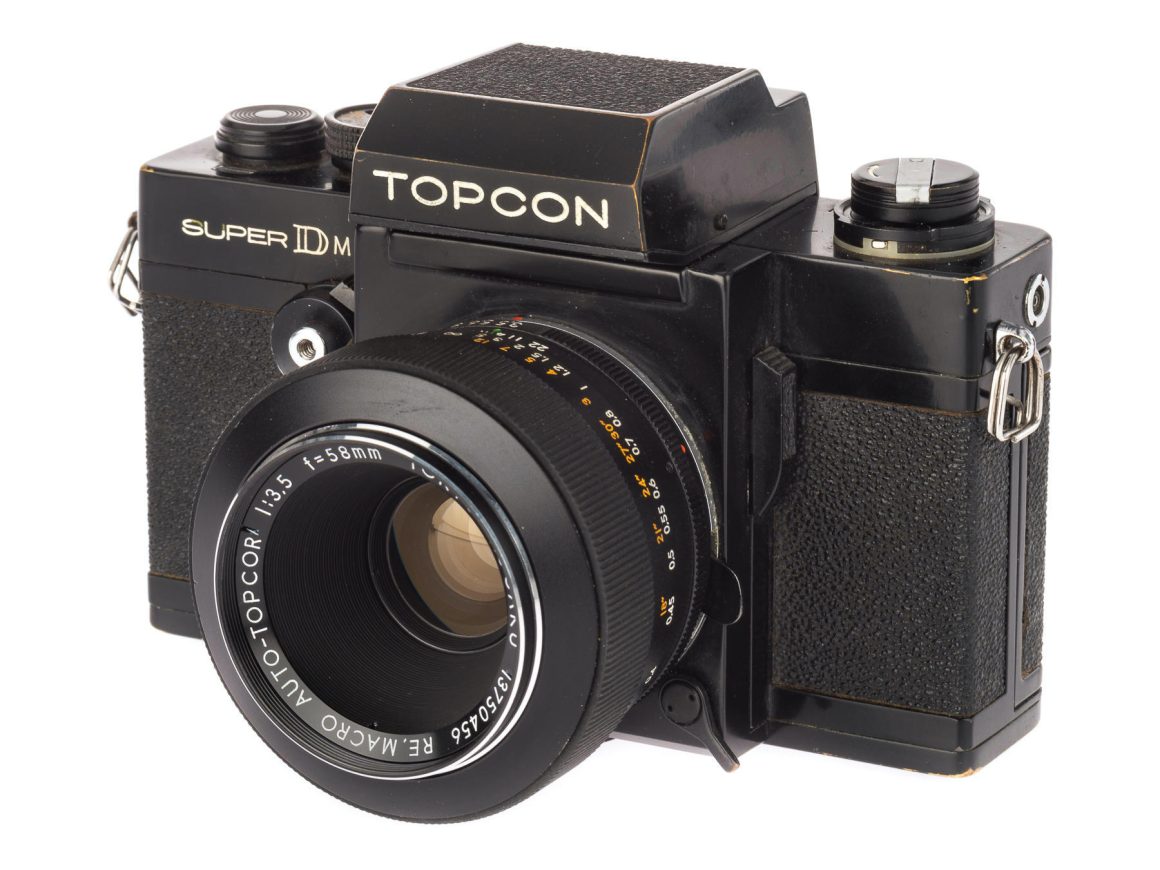
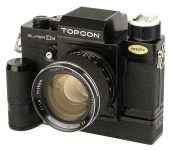
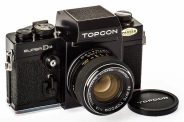
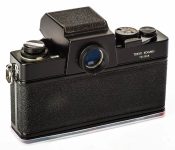
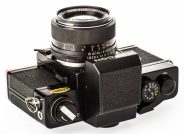
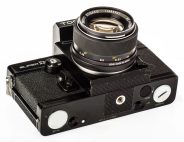

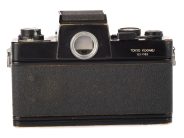
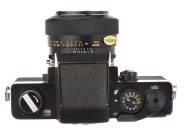
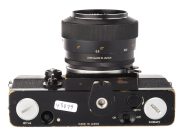
Accurate description of an exquisite camera that not many photographers know about. If they are given a CLA and perhaps a new shutter they are well worth the expense. The Topcor RE Auto lenses are phenomenal. Here are their specs… https://www.dyxum.com/dforum/re-auto-topcor-lenses_topic108389.html
This was the top of the line 35mm camera in its day and quite expensive. Thank you for your research. I liked them so much I bought 2 of them for a reasonable price considering their original price tag.